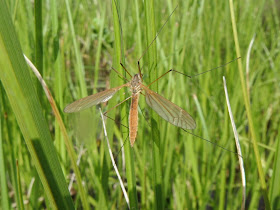With Blue
Winged Olive hatches starting to make their mark on most open streams, I
thought it would be a good idea to cover the next phase in the life cycle -
Emergers (click here for a review of the Baetis Nymph).
Emergence
is the point in the mayfly lifecycle where the nymph undergoes its penultimate
molt into the first adult (dun) stage. As with most mayflies, BWO’s emerge
mid-stream – the nymphs rise to the surface in a half swimming, half floating
manner. Once at the surface, the nymph hangs there in a near horizontal
position while the cuticle splits longitudinally at the thorax and the adult
literally crawls out of its skin onto the water’s surface. This process usually
takes several seconds and is sometimes complicated by the adult getting stuck
part way out (stillborn). Emergence is the most vulnerable stage in the mayfly
lifecycle.
In the
hour or so leading up to emergence, the nymphs become more active as they
jockey themselves into position in preparation for the event. Some will even
make a few trial forays off the bottom before they make their final ascent to
the surface. At this time a Baetis nymph worked in the middle to lower levels
of the water column can be devastating. As the hatch proper gets rolling, trout
will often focus on the nymphs as they near the surface. Again, a Baetis nymph
suspended a few inches under the surface will produce good results.
Once the
hatch is in full swing it will usually be the emerger that gets the most
attention.
If you
imagine what this stage might look like to a trout you would likely come up with
some kind of nymph/adult fusion fly – and that is exactly what most emerger
patterns look like. There are several BWO emerger patterns listed in the fly
tying literature, and a few available at your local fly shop. But the pattern I
like to use most often is a simple modification of my Baetis nymph pattern:
.jpg) |
| Baetis Emerger (deer hair wing) |
Hook: Mustad 94840 (or
equivalent), #16-18
Thread: 8/0
medium olive
Tail: olive
Antron
Abdomen:
medium olive dubbing
Rib: white
thread
Thorax: medium olive rabbit dubbing (a few hairs picked
out as legs)
Wing:
natural gray deer hair or CDC
.jpg) |
| Baetis Emerger (CDC wing) |
The Antron
tail imitates the translucent portion of the empty nymphal shuck as the adult
works its way free. The deer hair or CDC wing represent the adult that is just
starting to emerge above the surface. When fished properly this fly should sit
with the nymph portion of the fly just under the surface, being held afloat by
the deer hair or CDC. To accomplish this I apply dry fly dressing to the deer
hair only (the CDC pattern is fished without dressing). I also make sure the
Antron and dubbed body are wet before fishing the fly (I will often apply
saliva to ensure surface penetration on the first few casts). Note that the fly
will still hook fish even if it does land askew. I use the CDC version on flat
water and the deer hair version on rough riffles and runs; although the deer
hair version will usually work on flat water as well.
The
olive/gray color combination will match 70% of the BWO hatches you may
encounter but there will be times when the naturals do not live up to the blue
winged olive designation. This past weekend I fished a slow trickling hatch of tiny
dusky gray Baetis mayflies. My traditional olive/gray Baetis emerger pattern
was refused several times before I switched to a more exact gray/gray emerger
pattern – after this, the takes came consistently on the first or second cast
to rising browns.
Weather
tends to play a key role in BWO hatches. Some of the best Baetis hatches are on
days where the weather is less than ideal. Days of unstable weather with a mix
of sun and light rain squalls are ideal – most of the action will be from mid-morning
to late afternoon. Never let foul weather deter you from following through with
your fishing plans.
.jpg)
.jpg)
.jpg)

.jpg)
.jpg)
.jpg)


.jpg)
.jpg)
.jpg)
.jpg)


.jpg)
.jpg)
.jpg)
.jpg)